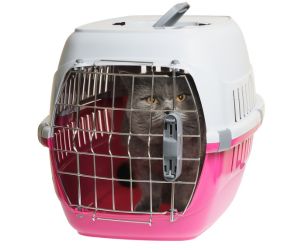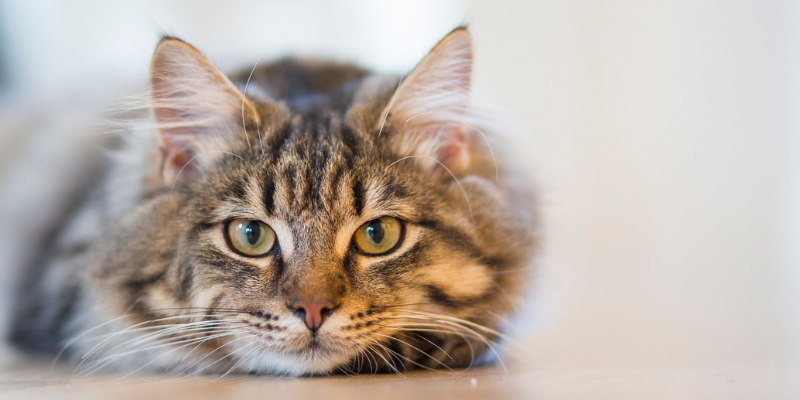Choosing a cat carrier
Material
 There are many different options of cat carrier on the market, from soft fabric types that are easy to store to strong wicker baskets that look nice when left out. All carriers have their pros and cons. Where soft fabric may be more lightweight, these carriers are difficult to clean and often do not have a solid base, making cats more nervous as the fabric shifts under their feet when they are being carried. Where wicker looks more aesthetically pleasing, cats’ claws can get caught between the fibres, causing injury, and wicker is very difficult to clean if your cat has an accident inside.
There are many different options of cat carrier on the market, from soft fabric types that are easy to store to strong wicker baskets that look nice when left out. All carriers have their pros and cons. Where soft fabric may be more lightweight, these carriers are difficult to clean and often do not have a solid base, making cats more nervous as the fabric shifts under their feet when they are being carried. Where wicker looks more aesthetically pleasing, cats’ claws can get caught between the fibres, causing injury, and wicker is very difficult to clean if your cat has an accident inside.
We highly recommend a hard plastic carrier with ventilation strips; these are easy to clean, sturdy and affordable. The carrier should have a front and roof opening to allow for flexible entry and exit routes. We also suggest a carrier which allows the entire top half to be removed so that if your cat is nervous they can be examined whilst still sat happily in the bottom half.
Size
The carrier should be big enough for your cat to lie down comfortably, stand and sit with enough room that they can move around a little. There should also be room enough for adequate padding at the bottom. It should not be so big that your cat will slide around or fall over. Remember, one cat per carrier, even if cats get along they should always be transported separately.
Security
Make sure all clips securing the carrier are present and working, especially if you have borrowed or purchased a carrier second hand. Make sure the carrying handle is attached firmly too.
Preparing the carrier
Unfortunately, as most cats are unfamiliar with their carriers, it’s common for cats to have accidents in their carrier so line it with some newspaper, a pet pee pad or an old towel. Vetbed is a great choice as it wicks away liquid and is also soft and padded.
Add some comfortable bedding like a blanket, ideally one that they sleep on so it carries their scent and the scent of home. Your vet can also use this blanket, if needed, to wrap them in during the examination. A blanket or towel can also be draped over their carrier which will give them some privacy and make them feel safe too.
Familiarising your cat with their carrier
The best way to make cat carrier use easier for you and your cat is to familiarise them with it. Leaving it out so it becomes ‘part of the furniture’ rather than a scary contraption that comes out of a cupboard just before a visit to the vet or groomers is the best way to do this! Place the carrier in a room where they feel safe and happily visit. Do this when they are not around so they do not see you and immediately assume they are going to be placed into it. The key is to take the next steps very slowly; start by placing their bedding or a few treats near to the carrier and edge them closer each day as they become more confident. You can even throw a few toys in for your cat to retrieve once they are comfortable entering the carrier.
Positive reinforcement with food will help solidify that the carrier is a safe and happy place to be. You can feed your cat in their carrier and offer treats as a reward if they settle inside. If your cat doesn’t respond to food, you can reward them with a toy, catnip or just some affection and playtime. Once they are at a stage where they will comfortably sit in the carrier, begin training to close the door for brief periods and reward each time. Remember to let your cat out as soon as they seem distressed at this stage. This may only be seconds at first, it will take time and patience before they are happy for an extended period.
When your cat is happy with being enclosed in the carrier with the door closed, you can proceed to lifting the carrier gradually, a little higher each time. The eventual goal is that your cat is calm and relaxed when being transported in their carrier.
Getting your cat into their carrier
Ideally your cat will voluntarily walk into their carrier, but getting to this stage will take some time and in an emergency you may need to take steps to get your cat into their carrier.
- Prepare their carrier and place it on a level, stable surface with the door open.
- Grab a towel or blanket, you will be using this to wrap your cat up and get them in the carrier safely.
- Distract your cat with a treat or toy and approach them from behind.
- Cover your cat completely in the blanket, head and body and gently lift them under the shoulders, wrapping the blanket underneath as you go.
- Speak softly and reassuringly as you go.
- Gently ‘post’ your now wrapped cat through the carrier entrance and securely fasten the door.
- You cat will extricate themselves from the towel, don’t try and remove it.
- Place a blanket or towel over the carrier to help your cat feel more secure.
Travelling with your cat
When carrying your cat in their carrier, hold the carrier close to your body and place a supporting hand underneath, this will help steady the carrier and feel less like a wobbly gondola trip for your pet!
Try to travel with your cat at least 2 hours after being fed to avoid toilet accidents and car sickness.
In the car they should be placed in the footwell or if there is not enough room then in the back seat and secured with a seat belt. Try to drive as smoothly as possible with minimal noise. Cats can get car sick as well as have accidents due to stress so a towel underneath their carrier just in case of leaks is a good idea. Just as with familiarising your cat with the carrier, they need to get used to travelling in the car; start with a short trip of a few minutes and gradually increase this until they become accustomed to a car journey without a vet visit at the end of it.
In the waiting room
At Heathfield Vets we have a separate cat waiting area with raised cat carrier ‘parking bays’; being raised above floor level can help reduce stress. We also provide blankets to cover your cat’s carrier, spritzed with Feliway or Pet Remedy.
Cleaning the carrier
Disinfecting the carrier is important, particularly after accidents and will help remove any vet ‘scents’ that could stress your cat. Cats are very sensitive to smells so use a mild non-toxic detergent to wash the carrier and rinse thoroughly with water.
Dealing with a very nervous cat
Some cats may never be happy going to the vets, there are so many stressors during the process of just getting them to the consult room that by the time the vet comes to examine them, they cannot be safely restrained or treated. And with each visit, this stress can snowball. For very nervous cats we recommend the use of pre-consultation calming medication, this can help make the process a more positive experience.
Call us on 01435 864422 if you think your pet may benefit from calming medication before their next visit.


